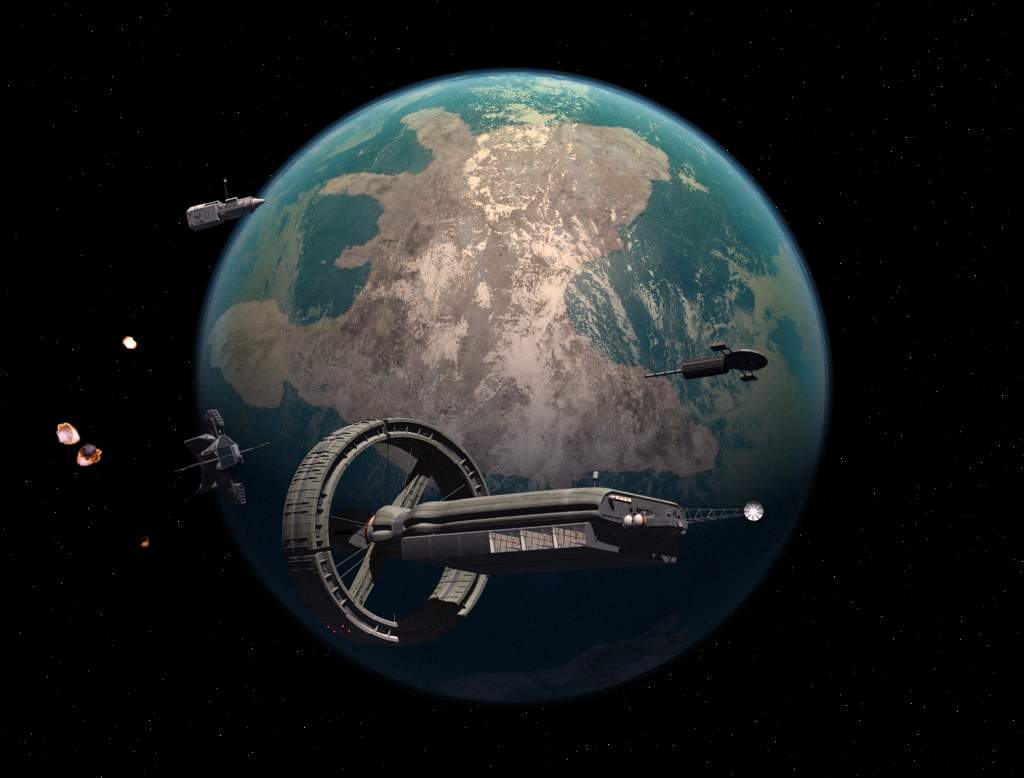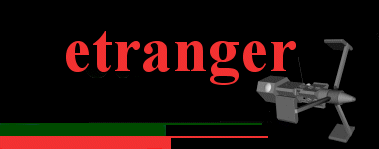
Verdun Class
Landing Ship Assault
By Bryn Monnery, Laurent Esmiol and D Hebditch
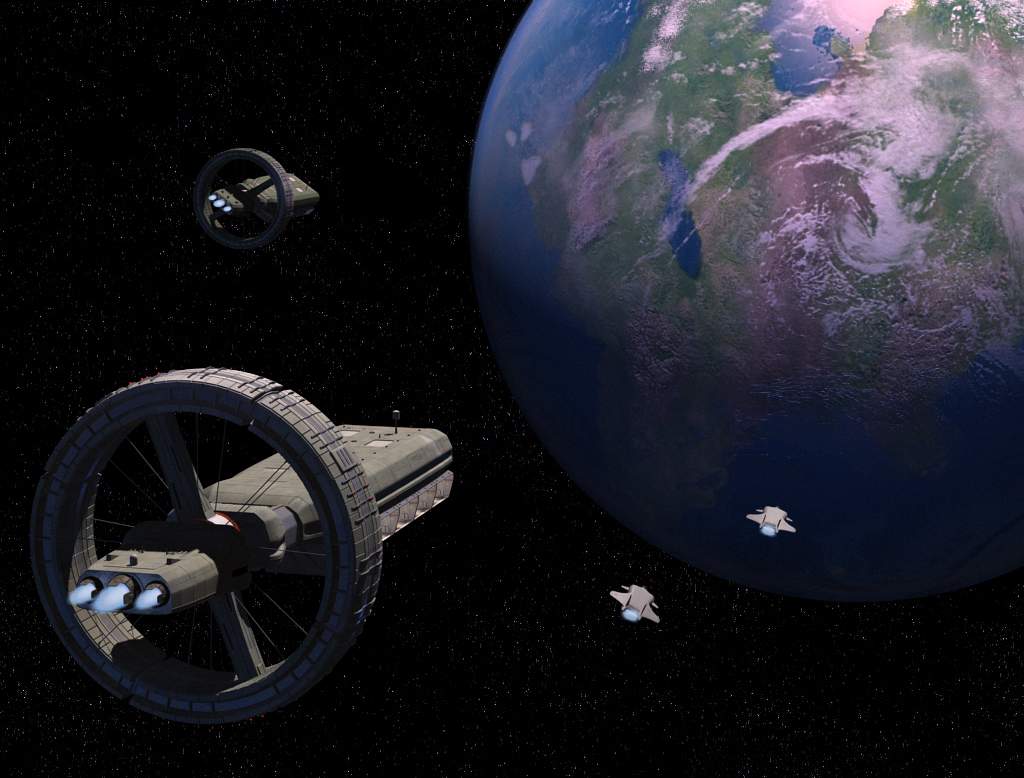
|
Above: IFS Dien Bien Phu and IFS Valmy closing on Beta Canum-4 in the opening stages of the 1st Liberation. The ship is accompanied by two of the surviving three Bonaparte fighters of the 8e GCS. (MSIF Media Ops) Introduction The Verdun Class were the first purpose built human starships designed to deliver large numbers of troops from orbit to surface simultaneously using a large number of small interface craft. Prior to this fast troopships existed but had only a limited number of landers available to them. The capability of the Verduns enabled French forces to conduct simple reinforcement missions, large scale raids, colonial shows of force as well as spearheading larger operations. The class set a precedent and was followed by the Americans, British and others. The Verdun and its sister ships are the most numerous assault craft in the human inventory, and although not the most modern have been the most conspicuous in the war against the Kafers so far. Acknowledgements All pictures are by Laurent Esmiol. The EdI is by Jonathan Pearson. Narrative The grognards of the II/1e REP were battered together despite the high impact harnesses that secured them in to the Tornade's crowded belly. Their lander accelerated hard away from the safety of the Dien Bien Phu, they couldn't see it but a further five assault craft were in close formation around them. Close below them now was the blue and green serenity of Beta Canum-4, their target as the initial wave. Fleet intelligence informed them that the Kafers had nearly 100 000 troops on planet, but confidently asserted that they were widely dispersed on counter-insurgency operations against human guerrillas. The analysts were positive that one concentrated strike could liberate Premiere and spark an uprising against the aliens. But then the analysts were safe in the armoured belly of the Richelieu and what did the Fleet know about ground warfare anyway? II/1e REP was the spearhead of the grandly titled 'Liberation of Beta Canum'. They were leading in fewer than 5000 veteran légionnaire-paras and American marines. Few of them had any illusions about making it back to the fleet alive and they noisily cursed their commander as the formation hit the atmosphere. |
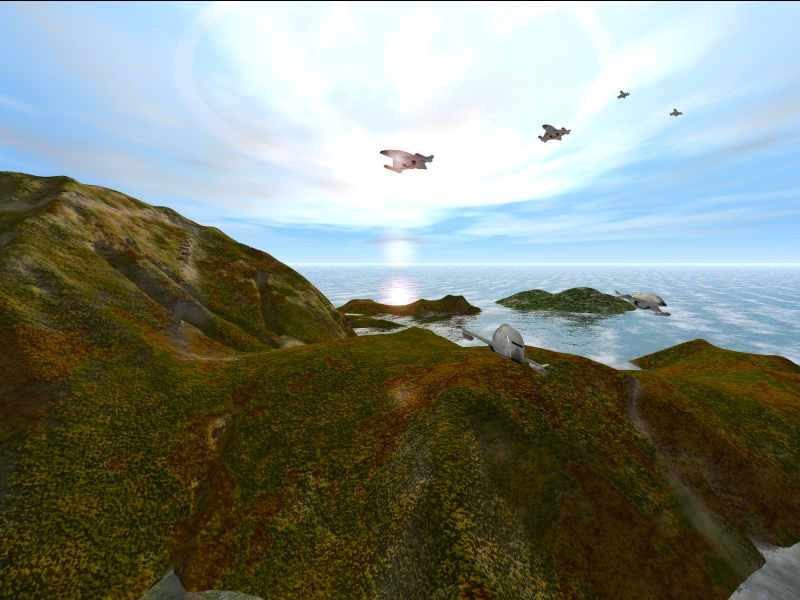
|
Above: A formation of Tornade landers cross the eastern coast of the French Continent of BCV-4 April 2302. Embarked with men of I/1e REP these landers are beginning a tactical NOE approach to the LZ. (MSIF Media Ops) Development The concept of the Verdun evolved from French experience in the Central Asian War. In this war the French mounted a number of raids into the Chinese Arm against isolated settlements and outposts. These were usually conducted by troops carried by the powerful Suffren Class Cruisers. However these were unable to deploy more than a company at a time, leading to a dispersion of combat force in the assault and the risk of troops being abandoned in the withdrawal. Similarly the French fast troopships proved too lightly armoured to risk in an assault orbit. The result was the development of a ship that could land large numbers of troops whilst having some degree of self-defensive protection. These could act either on their own in a raid or punitive expedition or as a spearhead to a larger landing. From the outset it was agreed that these craft would operate in the colonial arms and would have to be capable of long range sustainability. The Verdun Class ships were designed and constructed by the mammoth Rouchard-Ligget conglomerate in their facilities above both Earth and Tirane. Political pressures have affected the production of these craft with production being accelerated or almost cancelled depending on the ascendancy of Armée de Terre or MSF within the Junta or influence of different factions within the Empire. This stop-start nature of the project has also pushed up the unit price dramatically. However to date 7 of the Verduns have been completed but further construction has been put off due to emergency warship building programmes and debate on a possible next generation of assault carriers. The Verdun Class were named after pivotal battles in French history, some were glorious victories some humiliating defeats, but all had an effect on the development of France. Verdun was the first ship of the class completed in 2288 and took part in the evacuation of Kimanjano alongside the British ship Normandy. Borodino is most often found in the Sol system as is the Bir Hakeim although that ship was rushed up to QAS and took part in the Liberation of Kimanjano and BCB. Iena-Auerstädt was assigned to the Troupes d' Intervention Spatial of the 2e BI located in the Alpha Centauri system but didn't deploy with them to the French Arm, however it has recently replaced the Verdun on the French Arm. Dien Bien Phu is perhaps the most famous of the Verdun's having a long association with the légionnaire-paras of the 1e BI and has seen heavy fighting with Rochemont's Fleet alongside the Valmy. The DBP was also a ship closely associated with the newly formed Régiment de Parachutistes Coloniaux recruited from Vogelheim. The newest ship is the Aurore Libre which has just replaced the Valmy on the French Arm as the latter was in serious need of a refit. Below: IFS Verdun is the first of the Verdun Class ships. This image of the ship was taken during acceptance trials at Alpha Centauri in 2288. (Rouchard-Ligget S.A.) |
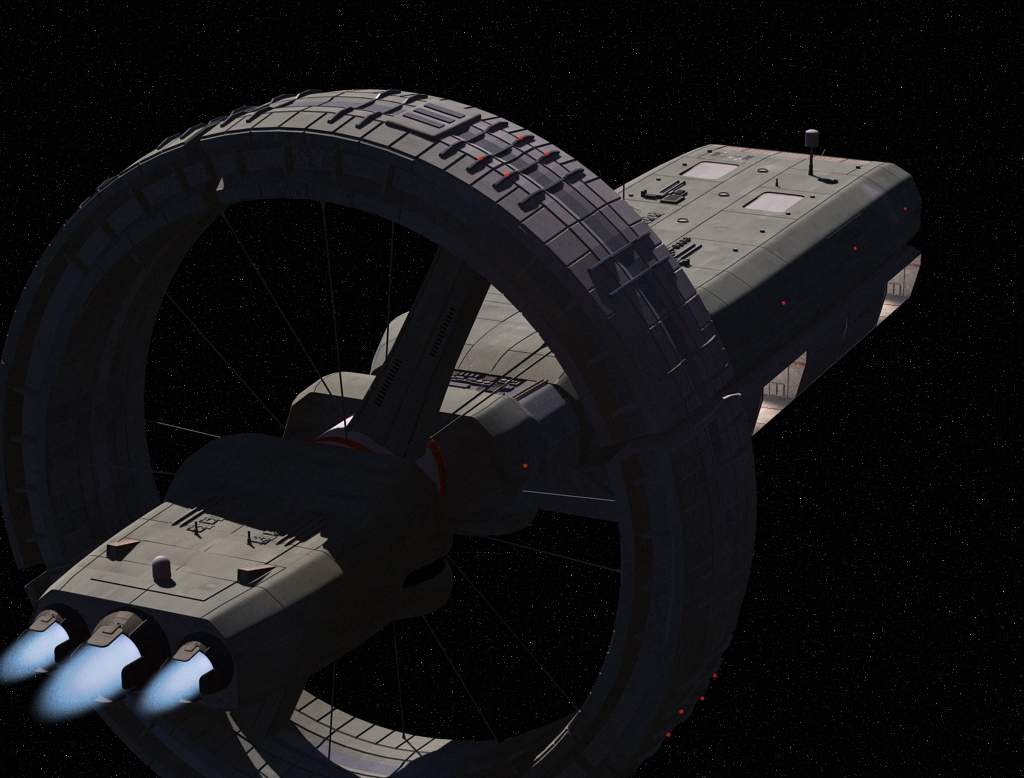
|
The Verduns have a distinctive configuration with a large forward deck, main spin habitat and engine compartment. The ship has a single large troop deck in the main ring. This includes all of the accommodation for crew and embarked force. The occupation levels of this accommodation can be altered to double the embarked troop compliment to 2000. Although this is usually done only on the lead up to an assault, during Operation Entente this figures were exceeded for the evacuation back to Beowulf. At normal occupation levels the Verduns are relatively spacious vessels which don't place undue stress on the troop complement which maybe embarked for long periods of time. Stores and hanger bays are located forward in zero-G conditions. The bridge is also located in this area forward of the spin habitat. The lower forward part of the ship is dominated by the lander hanger facilities, of which there are six on each side of the vessel. The weapons configuration for the ship is purely defensive, but includes a number of laser turrets. The engines and bulk of the engineering department are located aft of the spin habitat. |
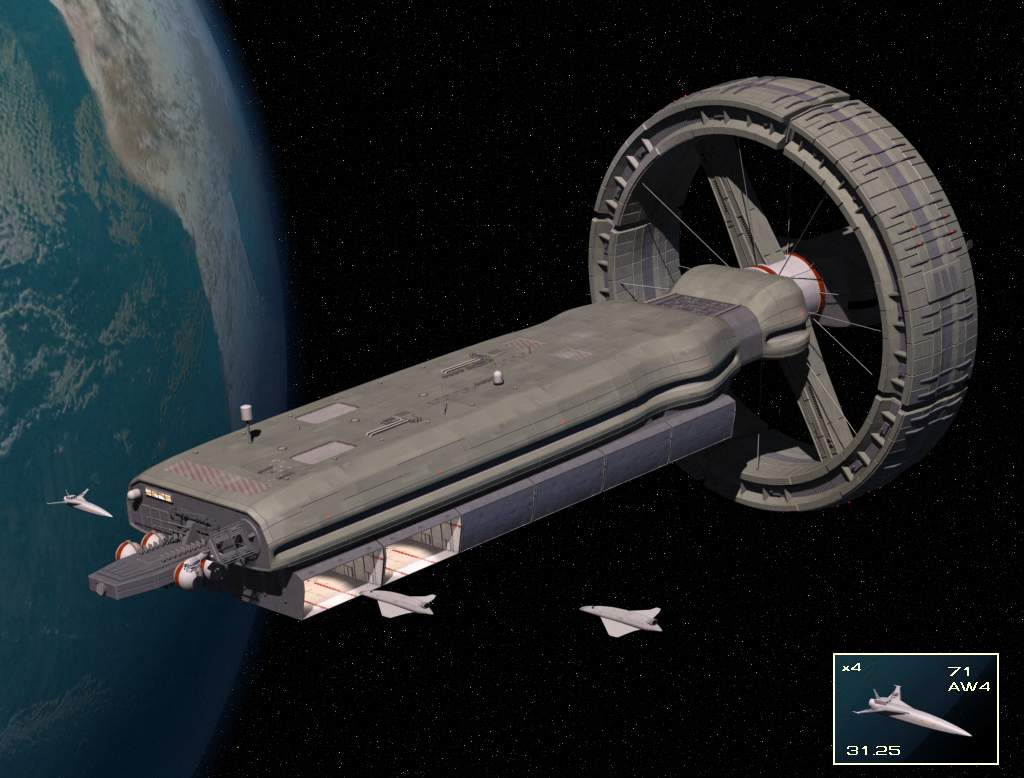
|
Above: IFS Verdun during docking operations in the final stages of Operation ENTENTE over Kimanjano. As well as the pair of Tornades a lander belonging to Air France is closing on the starboard side of the ship. The widespread use of civilian interface craft was a feature of this 'Dunkirk' style operation. (MSIF Media Ops) The Verdun Class operate as the centrepiece of a Division de Débarquement (DdD), a landing squadron operated by the EdI which controls all MSIF interface assets. A DdD is composed of one or two Verdun Class ships and accompanying military registered and crewed logistics ships and freighters. Unlike its British counterpart the Normandy, the Verdun is reliant upon a sizeable landing zone onto which to land its large landers. Consequently the DdD often includes cruisers and other warships to land the first wave of troops to seize an LZ and hold a perimeter. However during the Kafer War the Dien Bien Phu and other Verduns often exchanged some of their Tornades for the more manoeuvrable Zénith. This has proved a success and this practice may spread throughout the fleet. The Verduns are somewhat slower than most of their equivalents in other space navies. However they are capable of loading much more in the way of supplies, heavy weaponry and armoured vehicles. Pre-War MSIF DdD commanders often state that they prefer to actually be able to land with decisive force rather than rush light troops to a premature landing in advance of the main armoured forces which seems to be British and American practice. However Admiral Rochemont's actual tactics during the war have rendered this argument rather moot, and indeed there is actually little to choose from French, British or American assault landing tactics. The shear carrying capacity of the Verduns' landers make it an extremely important asset within the DdD. Indeed the first wave would usually be able to land the entire embarked force. This then frees the landers to begin bringing down troops or supplies from other ships within the DdD or auxiliaries attached to it. During the Liberation of Kimanjano the landers of Bir Hakeim and Verdun were used to bring down the troops of the second wave Divisions de Marche whose armoured vehicles were dead-dropped onto the LZ. |
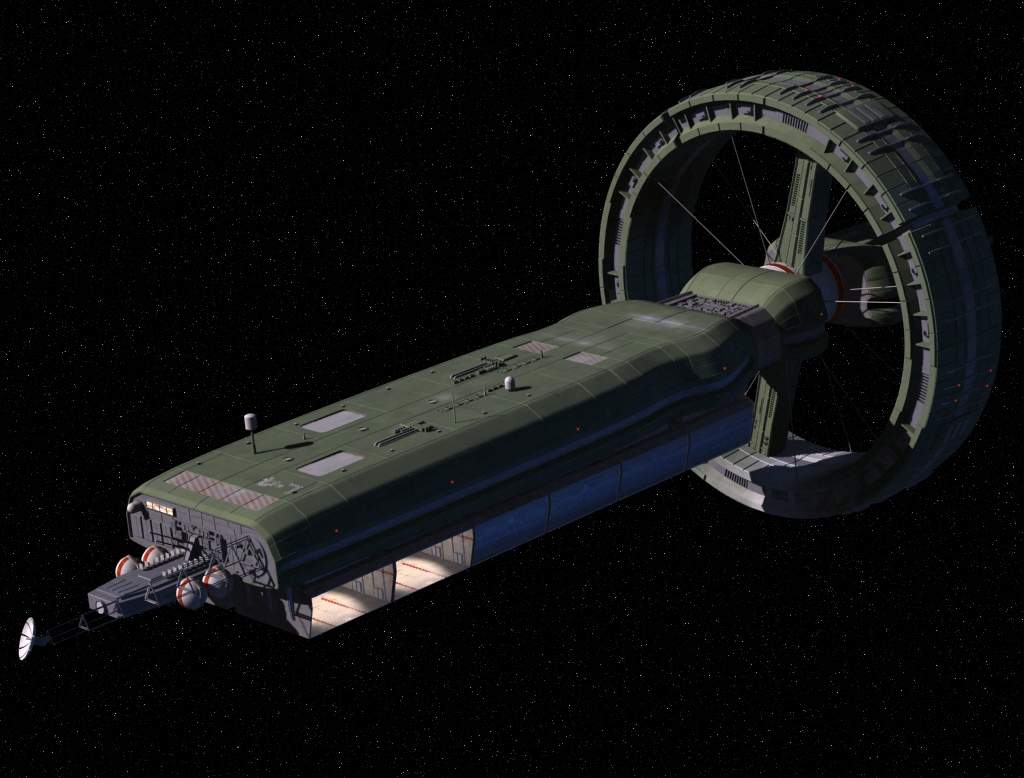
|
Above: IFS Dien Bien Phu in the Vogelheim system some time in 2301. Note that the ship had been painted a jungle green some time in the previous year. This move started a tradition that has spread to at least two other Verduns. (MSIF Media Ops) Ships Crew The ship's flight operations crew totals 66 personnel drawn from the MSIF. This is a fairly typical crew for a ship of this size. These ships are a reasonably prestigious command and most Captains are highly regarded in the service and all will have extensive experience of EdI operations. Interface Squadrons The Verdun carries an Escadron d'Assaut et Chute Orbitale, or assault interface squadron. This unit is found from the EdI and provides the ship's assault capabilities. These EACOs are usually equipped with the Tornade II lander although some have converted to the Zenith. The squadron is lightly manned with 12 pilots, 12 mechanics and 12 loadmaster/flight engineers. Consequently the ship's engineers may also have to help with the maintenance tasks. The EACOs are highly capable units and contain the cream of the EdI, their reputations have grown immensely during the Kafer War. Medical Facilities The Verdun carries an enhanced medical facility with no fewer than 80 staff, enabling it to operate as an effective hospital unit. Located in the main spin habitat it has a significant number of automeds and at maximum capacity can handle almost 250 casualties. A group of combat medics can also deploy with the embarked troops to reinforce their own medics and establish a ground casualty clearance station. The presence of these medical facilities, enough to cope with anything but an utter catastrophe is immensely reassuring to the troops. Embarked Troops A Verdun typically carries a reinforced battalion from a Brigade d' Intervention. This consists of a light infantry battalion of four rifle companies, two companies of combat walkers and combat support elements. These troops are drawn from the Para-Commandos, Marine Paras and paratrooper of the Foreign Legion. They are amongst the toughest soldiers France has to offer. In times of crisis the whole fighting elements of the BI cold be embarked on the ship. Alternatively the Verdun can carry a battalion of mechanised infantry and their AFVs or part of an armoured battalion. |
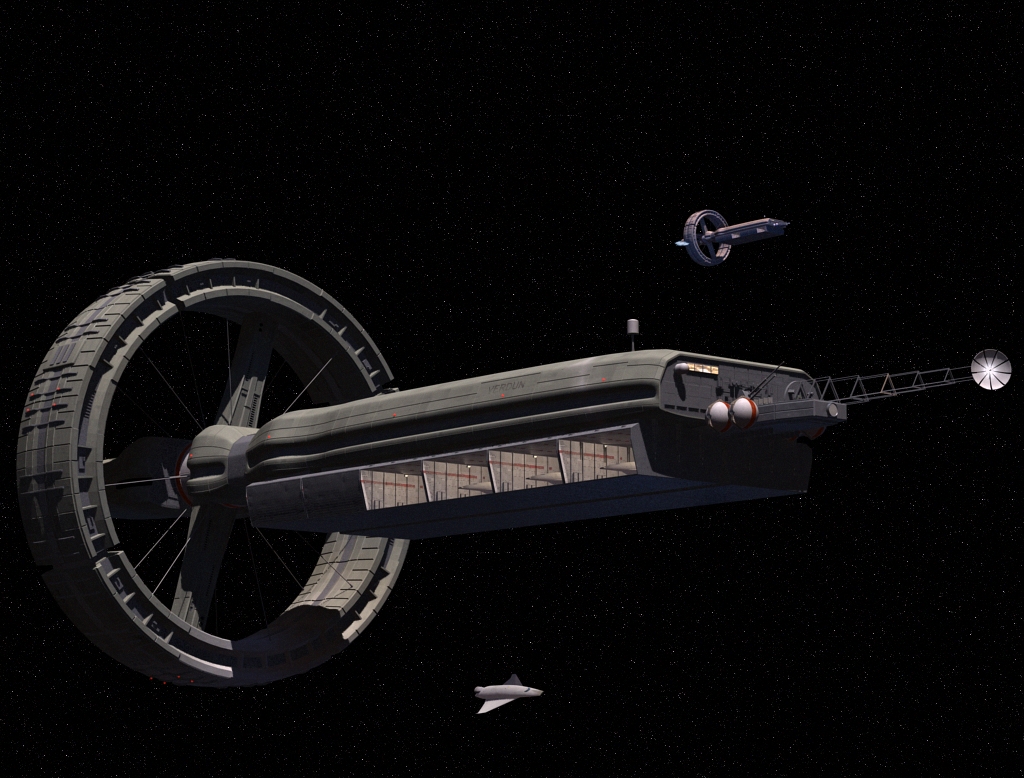
|
Above: IFS Verdun and IFS Bir Hakeim with shuttle doors open entering assault orbit above Kimanjano during the Liberation of that world. (MSIF Media Ops) No. in existence:
7 Performance: Warp Efficiency:
1.98 (standard load) (2.21 unloaded) Sensors: Weapons etc: Weapons etc: Hull hits: 414 |
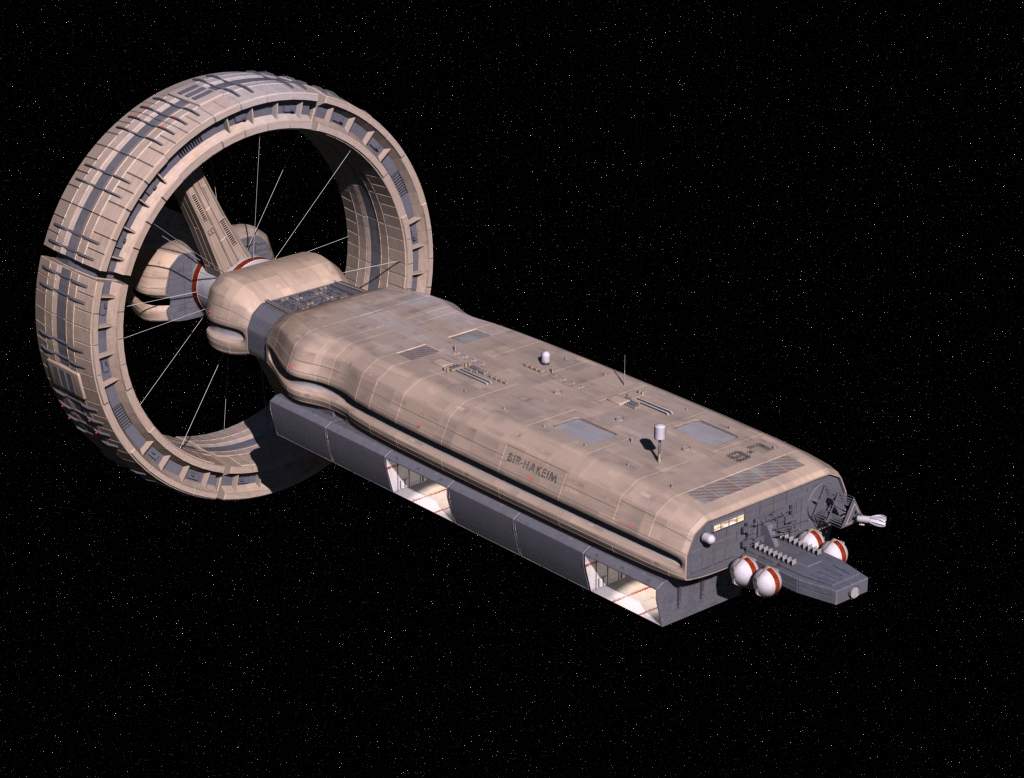
|
Above: IFS Bir Hakeim in the QAS system shortly before the Battle of Beowulf. Like some of her sisters she has a distinctive colour scheme related to her name, in this case reflecting the sandy battlefield of the western desert of North Africa. (MSIF Media Ops) L-1 Verdun The Verdun is the oldest ship of the class and came into service in 2288 at the end of the Central Asian War but saw no active service. Instead the ship saw itself as the centrepiece of a major intervention in the Elysian Rebellion with the newly organised 2e Brigade d' Intervention as well as elements of the 2e Division d'Infanterie de Marine from Nouvelle Provence. However with the crisis with Germany looming these forces were only able to delay the inevitable and the Verdun were involved in withdrawing the garrison at the end of the war. The Verdun served a long tour of duty on the French Arm and was involved in manoeuvres against German colonies during that war including movement of troops to Vogelheim and moves towards Dunkelheim and Hochbaden. The ship then returned to the core before moving back to the French Arm in response to the Invasion. As the flag of the 2e DdD she deployed with the 2e BI and further reinforcements for Kimanjano. However like many other ships she was blocked at QAS and the reinforcements never reached Kimanjano. Alongside the British Normandy she took part in Operation ENTENTE and the evacuation of Kimanjano where her heavy landers uplifted a significant proportion of those rescued. Verdun was heavily engaged in the viciously fought Liberation of Kimanjano and played a leading role in delivering troops onto the landing zone. She was damaged by surface fire but was repaired in-system despite an unexploded warhead lodged in her forward section. The Verdun has since been returned to Earth for more thorough repairs and is assigned to the 3e DdD. L-2 Borodino Commissioned in 2289 the Borodino has had a relatively quite career in comparison with some of her sister ships. Indeed the ship has only engaged in exercises in the Sol and Tirane systems and made the occasional foray down the Chinese Arm. She has remained in the core throughout the Kafer War as the flagship of the 3e DdD. It is planned that when the Dien Bien Phu returns from the French Arm the Borodino will replace her. L-3 Iena-Auerstädt Commissioned in 2291 the Iena-Auerstädt has spent in the Alpha Centauri system although it spent a 5 year tour on the French Arm from 2294-99. The Iena-Auerstädt sat out most of the Kafer War although she was despatched to the French Arm in the summer of 2302 to replace the damaged Verdun and replaced that ship in the 2e DdD. She is currently stationed in the Kimanjano system. L-4 Dien Bien Phu The Dien Bien Phu came into service in 2295 and was the first Verdun commissioned after the fall of the Junta, which may account for its unusual name. The DBP was despatched to the French Arm after trials and has remained their ever since. The ship was involved in the movement of troops to Eta Bootis for the relief of Aurore in 2298 and was routinely involved in the rotation of troops to that world from the Beta Canum Cluster. However when news of the destruction of Hochbaden reached Rochemont the 1e DdD of which the ship was a part was mobilised and embarked the elite 1e Brigade d' Intervention. The DBP was involved in the manoeuvring of the fleet in the autumn and winter of 2301 based in the Vogelheim system. In March the ship undertook its first landing operation, deploying not its own 1e BI but the Anglophone Joint Vogelheim Brigade. The landers were also used to shuttle British, Azanian and even some Elysian forces to help defeat Kafer forces in the Japanese colony. However this success was not repeated when in April 2302 the ship was involved in Rochemont's abortive operation to liberate BCV, successfully landing the entire 1e BI inside an hour. Unfortunately the return of the Kafer fleet returned and forced Rochemont from the system, and the DBP was forced to abandon the troops. Later operations saw the DBP return to BCV with the Régiment de Parachutistes Coloniaux in July, landing the RPC and elements of the JVB. Since then the ship has been busy being involved in relief efforts on Nous Voila and bringing in additional French and Polish forces. The ship remains in the Beta Canum cluster with the 1e DdD which has been reinforced with the commissioned Bir Hakeim. L-5 Valmy Completed in 2297 the Valmy was sent to the French Arm with the 4e DdD and with 4e BI and a US Marine force embarked, travelling in the same force package as the battleship Napoleon. It was originally intended that the 4e BI be used for reinforcement of Aurore or in a liberation attempt on Dunkelheim or Hochbaden but this plan was overtaken by events. Instead the 4e DdD joined the 1e DdD in support of Rochemont's Fleet. The Valmy was involved in landing the JVB on Joi and later took part in the attack on Beta Canum landing the US Marines but ultimately having to abandon them. However in May the Valmy was the spearhead of the Liberation of Crater dropping the 4e BI in an opposed assault of Rimview which very nearly failed on the Landing Zone. Having cleared the city in concert with British guerrillas the Marines were then withdrawn to lick their wounds. There was little relief for them as they were then thrown into the '2nd Liberation' of Beta Canum in July again being landed by the Valmy. The ship has been busy since then but has since returned to the core for a refit, handing over the 4e DdD to Aurore Libre. L-6 Bir Hakeim The Bir Hakeim was commissioned in 2299 and was sent in early 2302 to reinforce the Verdun at QAS, bringing with it reinforcements for the newly named Armée de Liberation on Beowulf. It took a major role in the Liberation of Kimanjano landing Azanian paras in the first wave before helping bring in the second wave. The ship was then involved in landing the 11e Division Parachutiste on Beta Canum as well as subsequent operations. The ship is now part of the 1e DdD with the Dien Bien Phu together they provide France's starlift reserve in the Beta Canum Cluster. L-7 Aurore Libre The Aurore Libre was completed in 2301 and rushed through her tests and alongside the Borodino was stood to in case of a failure of the Reserve Fleet at Beowulf. Since then with the return of the tired Valmy she has been sent to the French Arm and is now part of the 4e DdD stationed at Vogelheim but making regular runs to Eta Bootis and available for landing operations in the Eta Bootis finger. |
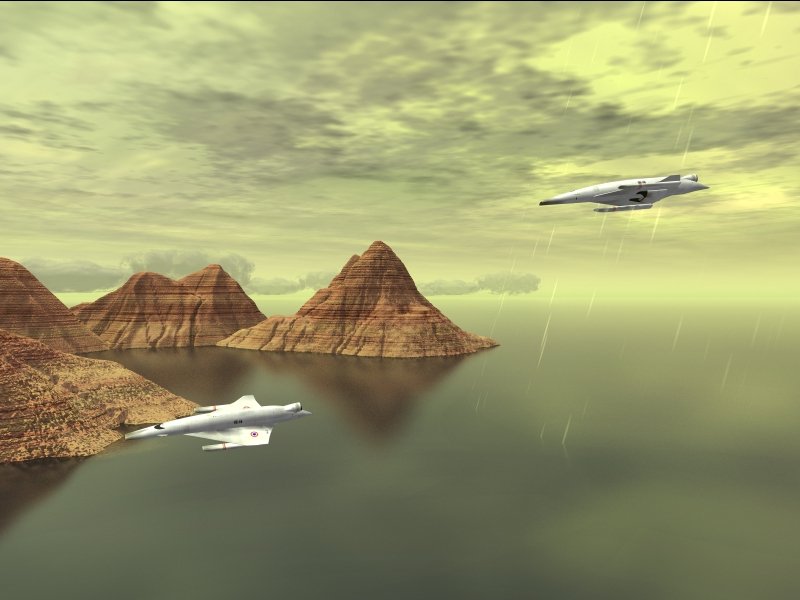
|
Below: A formation of Tornades from the Verdun during Operation ENTANTE, the evacuation of Kimanjano. These large landers were responsible for uplifting nearly 70% of those troops and civilians rescued. (Marie Slovenskii) The all important landers, without which no assault ship can function were supposed to be the same VSTOL design being developed for the Richelieu Class battleships. Heavily armed and armoured, capable of delivering two squads of troops or a small armoured vehicle to the surface under the worst conditions. However these Zénith were proving unreliable, and the option remained to go with the tried and tested Tornade II design. The Tornade II is an update of this workhorse lander that has been in service since the 2260's. Whilst capable of undertaking any uplift tasking and having an impressive troop carrying capacity the ship has a number of flaws, mainly the lack of VTOL capability. The lander is robust and capable of 'rough' field landings but still requires a sizeable landing and take-off area. The Engine is a ducted rocket, burning hydrogen fuel. It has two burn modes, jet, which is only useable within a significant atmosphere, is a conventional jet engine, while in a vacuum (or when very high speeds are needed) the rocket mode provides considerably more thrust, but consumes much more fuel. Acceleration in rocket mode with the afterburner can reach 2.6G allowing for rapid ascent and descent into combat zone. If fuel consumption is not an issue then the Tornade two can reach Earth Orbit from the surface is less than 19 minutes, consuming 25 tons of fuel. From there it must use its thrusters to manoeuvre to the carrier. Type:
Interface Interface assault STOL Spaceplane |
